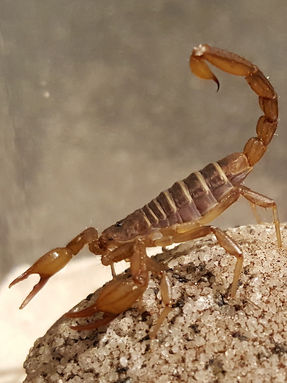
Northern Scorpion
Scientific Name:
Paruroctonus boreus
Type:
Invertebrate
Habitat:
Desert and high desert
Range:
All areas of Nevada, including the higher elevations and they are native to the Great Basin, Sierra Nevada mountains and western United States
Status:
No listed status
This species is
NATIVE
to the Truckee Meadows.
Identification:
Northern scorpions have segmented features on their exoskeletons that range between light brown to dark brown in color. They have long tails with a stinger on the tip and two front pinchers that do not work as legs. Scorpion tails can curve up and over the top of their body, especially when defending themselves or approaching prey. These scorpions are usually around 2.5 inches in length. Some people compare scorpions to very mini lobsters due to their shape.
Fast Facts:
Northern scorpions tend to be mostly active at night, making them nocturnal invertebrates.
Scorpions fluoresce under blacklights, a technique that helps scientists study them at night.
Scorpions eat insects, small snakes and lizards and other arachnids, including other scorpions. They will capture their prey with their front pincers then use their tail to inject the venom via the stinger.
Scorpions are prey to some types of snakes, owls, and some types of mammals.
Female scorpions give birth to baby scorpions; young are not hatched. The young are born live 7 to 9 months after gestation;
Baby scorpions crawl onto the backs of their mothers, where they will stay anywhere from up to 50 days or so. This is done so that the baby scorpion can shed its birth skeletal system and grow a hardened one.
While the baby scorpions are on their mother’s back, they consume food from within their own body system, but water is moved between the mother Scorpion to the baby scorpion, through a body part called a “cutile”.
Northern scorpions will burrow in areas such as small holes that have been abandoned by other creatures, or under bricks, bark, or other landscaping material. They can also hide in empty shoes left outside, so shake your shoes before putting them on;
The sting of northern scorpions are typically not lethal to humans. Caution, however, is still advised in case of any adverse reaction.
Here in the Truckee Meadows, scorpions can be spotted in nearly every natural desert park (like Hidden Valley Regional Park) due to their abundance.
Sources:
https://www.britannica.com/animal/Scorpion/Ecology-and-habitats
https://eden.uktv.co.uk/animals/invertebrates/article/scorpions/
Image: Xbuzzi, https://commons.wikimedia.org/wiki/File:Northern_Scorpion,_Paruroctonus_boreus.jpg, license https://creativecommons.org/licenses/by-sa/4.0/deed.en, cropped from original.
Contributor(s):
Pam Del Porto (research & content)
Alex Shahbazi (edits & page design)








